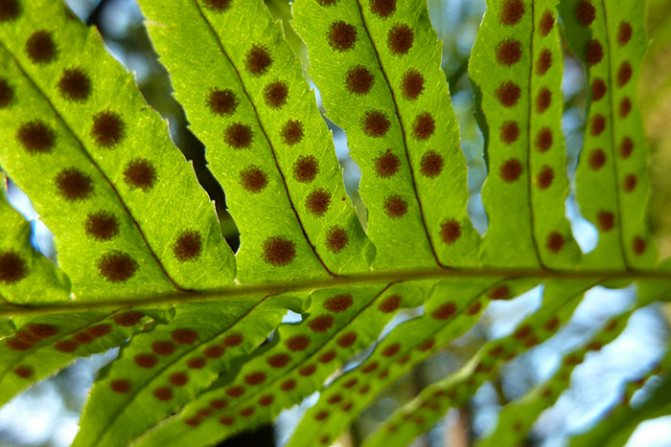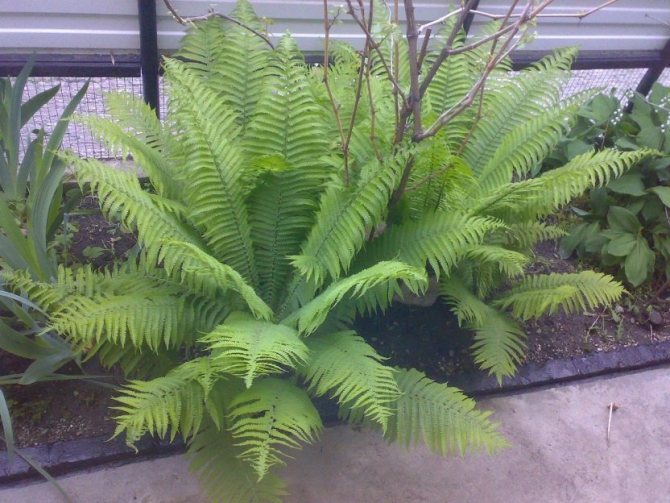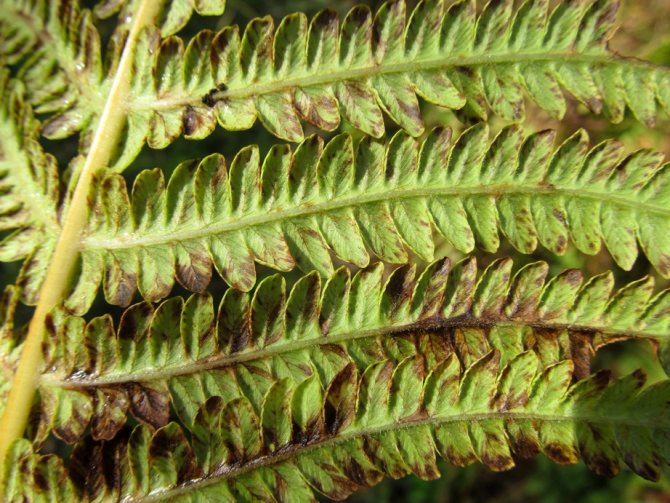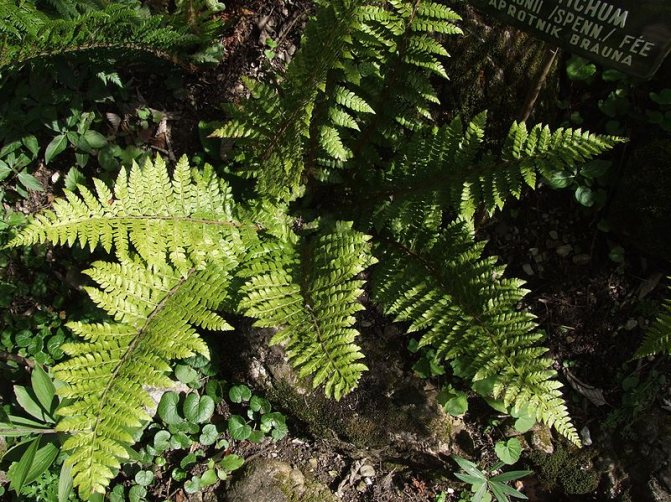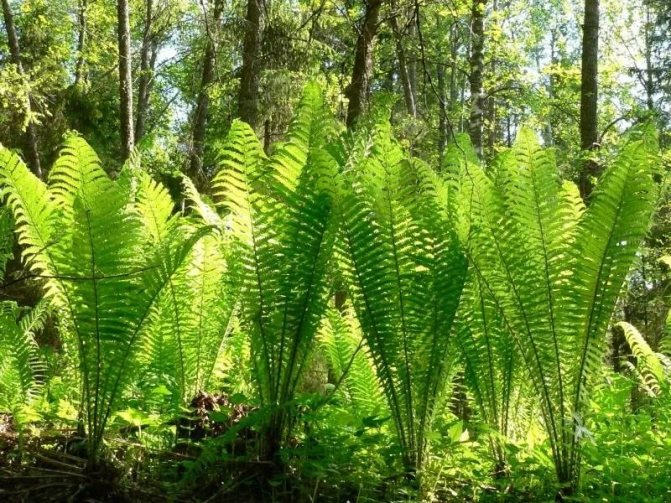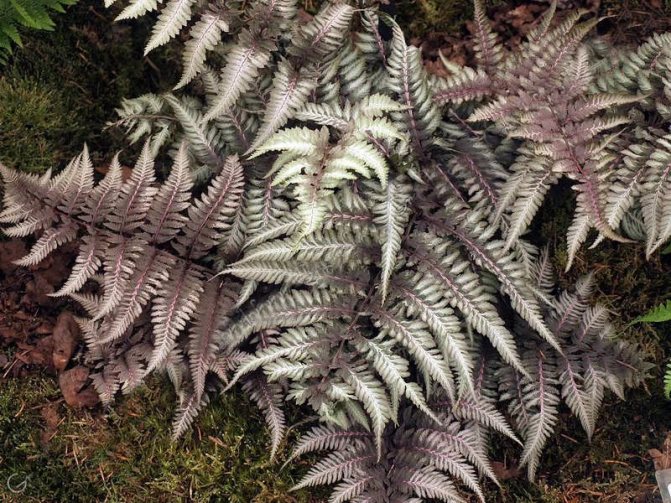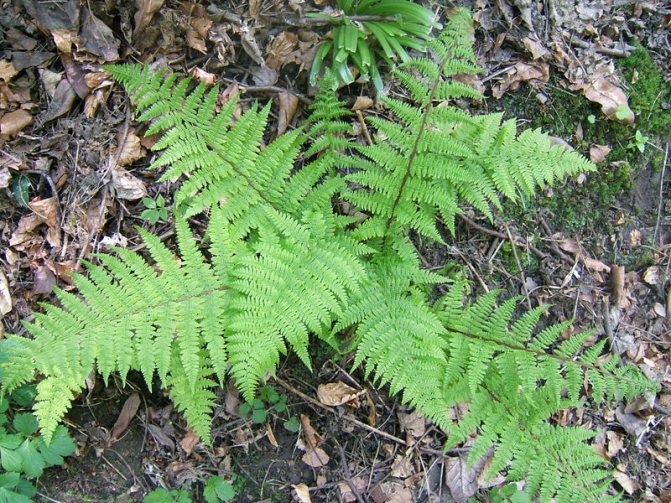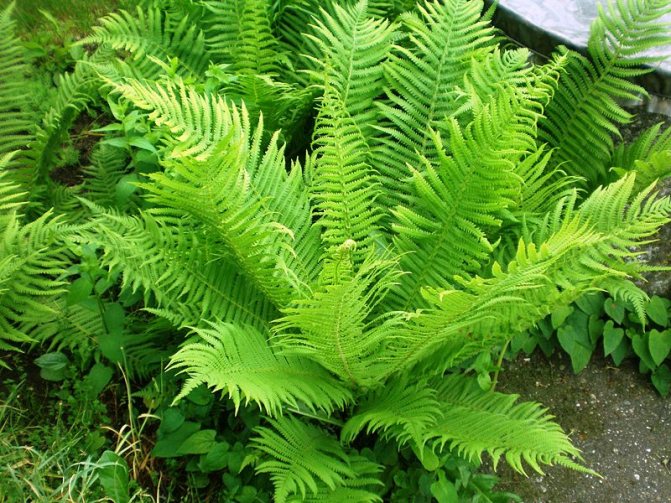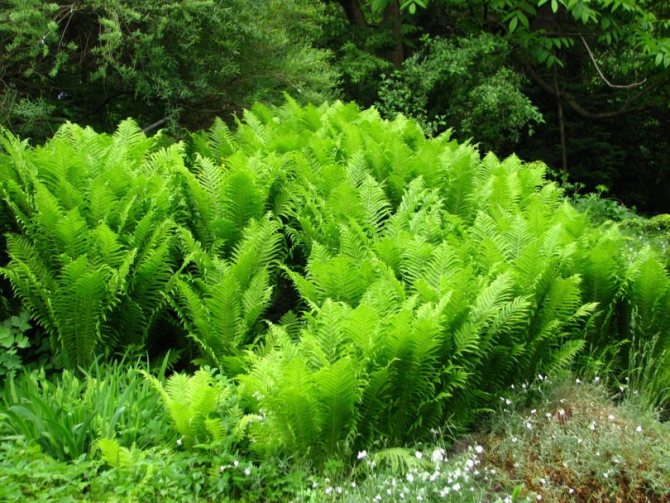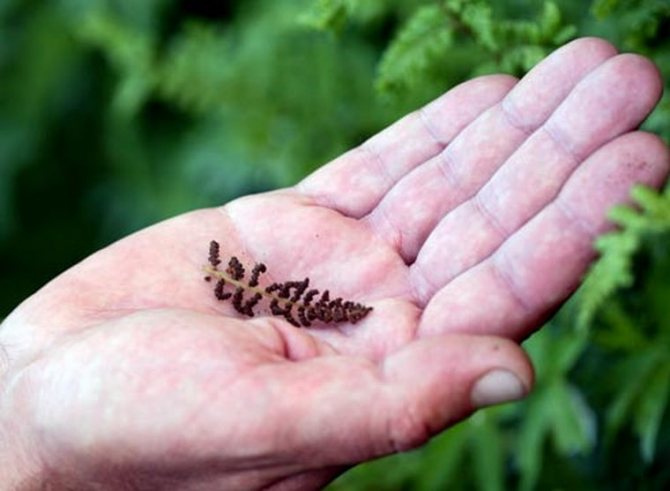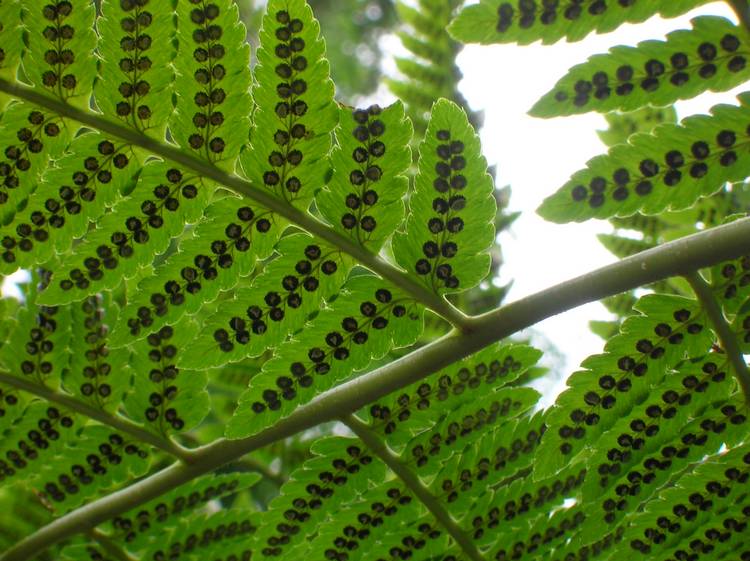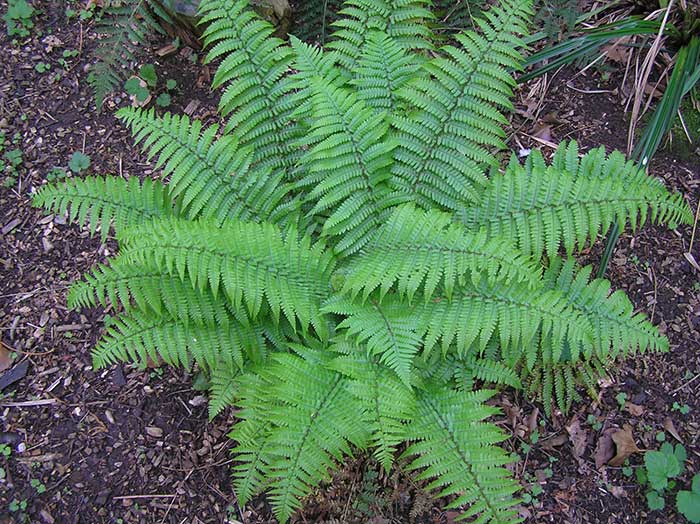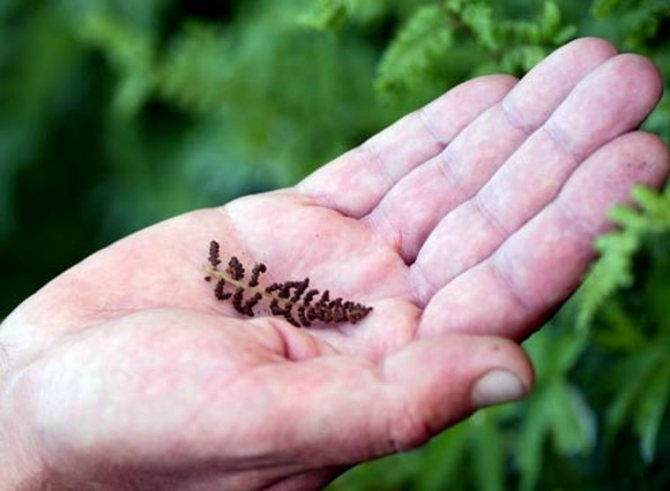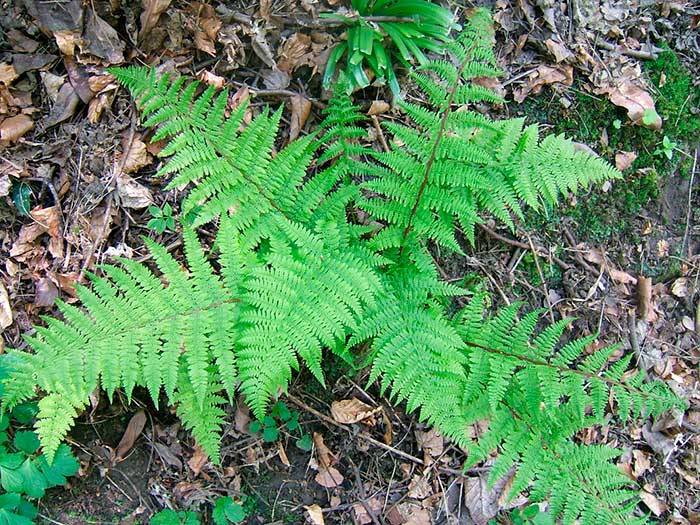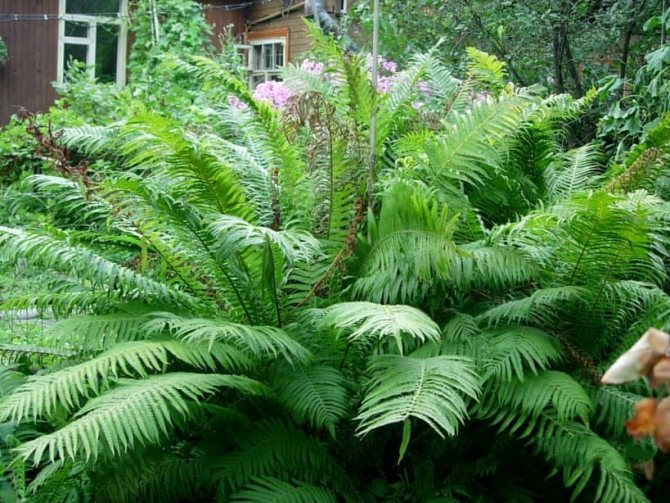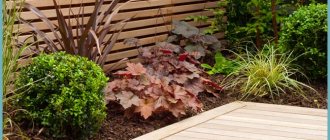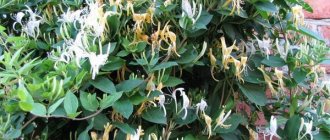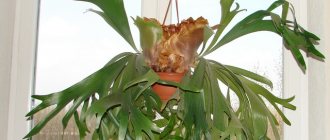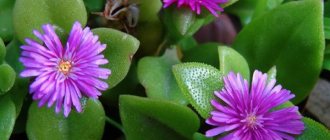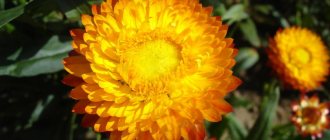There are many legends and beliefs about him, but this is all for romantics. For a practical gardener and those who appreciate the beauty and comfort of a summer cottage or a country house, its other advantages are important - decorativeness, unpretentiousness to care and climate and undemanding to the place of planting. They are irreplaceable in the design of landscape compositions. The shade tolerance of the fern is truly unique, which means that it will always find a place on your site, especially where there is a need to hide their unsightlyness. How to get luxurious fluffy thickets in the part of the garden where other plants simply cannot survive?
Interesting fern facts
Ferns grew on Earth as much as 400 million years ago, back in the era of the dinosaurs. A lot of water has flown under the bridge since then, a lot of ice has appeared and melted, and the fern continues to live. A great many different species of this unique plant are found on the planet at the present time - more than 10 thousand. Among them are both herbaceous and tree ferns. Most of them are terrestrial, but there are some that grow on rocks, in lakes and rivers, or on the trunks and branches of trees.
We are all used to seeing ferns with split leaves - by the way, they are called fronds. But it turns out that among the ferns there are species with ordinary - whole - leaves.
Actually, these are not leaves. In reality, a frond is a branch (shoot) with leaves. And ferns simply do not have a leaf as such. As, however, and the stem we are accustomed to. The stem of these amazing plants is the rhizome, which is in the ground. The adventitious roots extend from it. New fronds grow out of it.
In the state of the embryo, this shoot (called "pre-run" in botany) is twisted in the form of a spiral.
As it grows, it straightens more and more until it turns into a flat vayu.
Diseases and pests
Usually the fern rarely suffers from diseases, but if the growing conditions are grossly violated or there is an unfavorable neighborhood, you can encounter both a fungal infection (fungi of the Phyllosticta species) and a bacterial one. Outwardly, it looks like this: the leaves turn yellow, then turn brown and die off. A dark bloom is possible only on the back of the leaf, or the central vein is affected (then we are talking about such a formidable disease as a leaf nematode). In this case, you will have to part with the plant, and it is better to dig up the infected soil and throw it away. Fungal infection can be fought by cutting off all dry and affected leaves, and carefully treating the remaining plant with a fungicide. In the future, special attention should be paid to watering and loosening.
Among the insects that can infect a fern, scale insects, mealybugs and fern aphids are more common. In this case, various insecticides help well. The main thing is not to forget to eliminate the reason why the plant has weakened, otherwise the disease will return again.
The variety and beauty of ferns, their unpretentiousness allow these plants to take their rightful place in the landscape design of summer cottages and backyards. This small oasis will not only hide unsightly places, empty due to lack of light, but also give a lot of aesthetic pleasure.
How to propagate a fern?
Ferns are propagated in several ways, but the most popular two are spores and vegetatively.
Method 1. Disputed. Very interesting from a botanical point of view. Ferns have two completely different forms of existence, two life cycles - sporophyte and gametophyte. They exist independently of each other. What we used to call a fern is not really a fern. This sporophyte is asexual generation.
The Slavs have a wonderful legend that once a year, on the night of the holiday of Ivan Kupala, a fern blooms. Its bloom lasts only a few moments. Anyone who is lucky to pick this incredibly beautiful flower will become the owner of amazing abilities.
In reality, ferns never bloom. For this reason, they cannot have seeds. The role of seeds is played by spores. They are located on the underside of the frond in special bags - sporangia. After ripening, the spores get enough sleep and wait in the wings. In order for a new life to begin to develop from them, moisture is needed.
After the spore enters a humid environment, it begins to grow. A small - from 0.5 to 3 cm - sprout is born, having the shape of a heart - a sprout. Here it is - the second life of a fern. This sexual generation is a gametophyte. There are both female and male germ cells on the outgrowth. When moisture appears, fertilization occurs and a young plant is formed. This is again a sporophyte, which later will have spores, and everything will go around again.
Reproduction by spores is a fascinating, but rather lengthy process, which is why most gardeners grow ferns vegetatively.
Method 2. Vegetative. Less laborious and consists in dividing the rhizomes of sporophytes. Thus, the ferns are divided in early spring, when the time of frost has passed. If you did not have time to divide in the spring, then you can do it in the fall as well.
To propagate a plant with a long rhizome, you need to separate a part of the rhizome with a bud and at least a few roots and transplant to a new place.
But what if you have a fern with a short rhizome and a rosette of wai? In this case, you need to divide the bush so that each of its divisions has at least 2-3 sockets and a root system.
There is another type of vegetative propagation of ferns - division by side shoots. These shoots resemble a strawberry whisker. The side shoot must be buried a few centimeters into the damp ground.
Make sure that the soil does not dry out. For the shoot to take root, the soil must always be moist.
In about a month, you will see the first leaves. However, do not rush to plant a young plant, let it gain strength. You can start transplanting when the fern has 3-4 leaves.
Fern breeding
Many gardeners are wondering what is the best way to plant a fern in the country. After all, it reproduces in three main ways:
- Division of the bush. The easiest way, compared, for example, with spore seeding. It involves a simple separation of the bulbs and their subsequent seating along a perimeter prepared in advance. It is best to do work on dividing the bush in the spring. After that, it is immediately possible to start planting. If you store a bush divided in advance for the winter, then some specimens will not survive the shelf life;
- Rhizome mustache. Not every type of fern can be planted in this way, since not all tendrils grow. For example, in cordifolia nephrolepis, they look like aerial processes spreading over the soil. If you bury them in the ground and carry out intensive watering, then you can soon get a new plant;
- Brood buds (spores)... This method can be considered, perhaps, the most time consuming and least productive.For planting, it will be necessary to separate from the upper parts of the leaves, place on peat soil or on moss and moisten daily. Immediately after this, it is important to cover each spore with a jar and remove to any warm place. Soon the “kids” will take root and after a month they can be planted as a full-fledged plant.
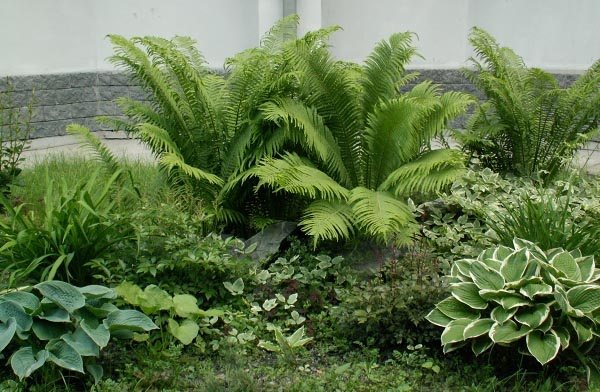
The best place to grow a fern
In the wild, the fern grows in shady forests under spreading trees, this must be taken into account when planting in a summer cottage. The plant is unpretentious in the soil. It grows even in unfertilized soil, but it needs moisture for a comfortable existence. If there are tall trees or extensive shrubs on the site, then ferns should be planted under them, this will provide them with sufficient shade.
The plant will be comfortable where many crops will not survive - on rocky soil. Another requirement when choosing a place for a fern is free space. The plant is characterized by fast and active reproduction, so it needs an artificial fence. This can be done by digging a sheet of roofing material or other dense material around the proposed country flower bed with flowers. This trick will prevent the roots of the plant from spreading throughout the garden and sprouting.
Some species of this plant are able to live in sunny areas, but in such growing conditions they become smaller, and the leaves become lighter. In this case, you should not expect abundant thickets.
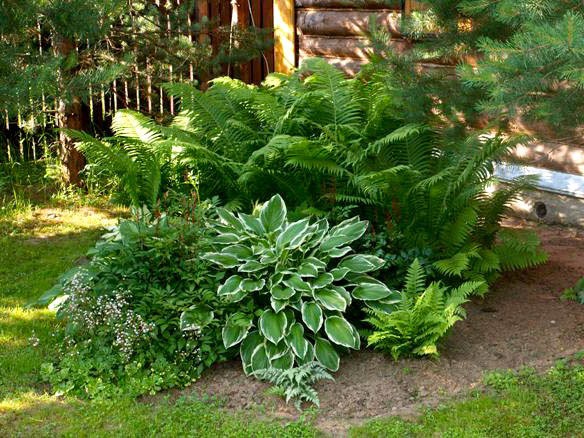

Fern planting
The best period for transplanting a fern is early spring, when the plant is just beginning to bloom fronds (leaves). If it is necessary to transplant a fully opened plant, it is necessary to carefully monitor so as not to damage the clod of earth that tightly holds the root system.
Before planting a fern, you need to know some rules for the care and maintenance of this perennial. If you want to get a ready-made plant, then you can dig it up in the forest. So you will be sure that it will take root, as it is grown in home latitudes. But there are other methods available for growing.
As for the place where the fern was planted, then it should be planted in wide holes, no more than 0.5 m. Part of the land that needs to be brought into the hole should be from the place where you took the process from. You need to transplant the fern right away so that the roots do not have time to dry out. Otherwise, it will not be possible to revive the plant. The same should be taken into account in the leaves. The stems should not be withered. Do not separate the soil from the roots, it will be better if you dig up the fern in such a way that a lump of earth remains on the rhizome.
The best period for transplanting a fern is early spring, when the plant is just beginning to bloom fronds (leaves). If it is necessary to transplant a fully opened plant, it is necessary to carefully monitor so as not to damage the clod of earth that tightly holds the root system.
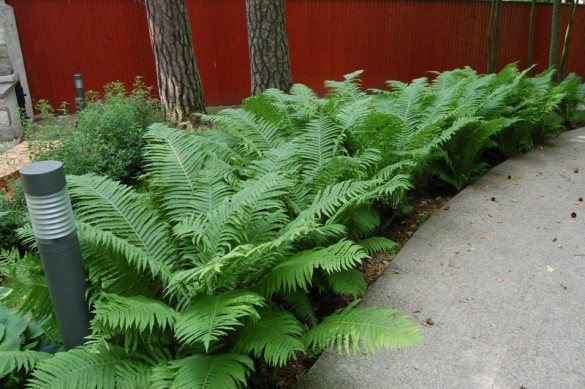

Fern care
The fern is unpretentious, so it's easy to take care of it. The main condition for its healthy growth is moisture. In order for the soil around the plant not to dry out, after planting it must be covered with a thin layer of deciduous mulch. The stones laid out around the bush will help keep moisture in the soil. For these purposes, it is best to use river pebbles or gravel, which will retain moisture and will be an excellent decoration for the entire garden composition.
The garden fern, which is easy enough to plant and maintain, even for a novice gardener, is one of the most unpretentious plants. In addition to watering abundantly, the process of caring for it will include, for example, creating mulch. It is especially important to do it in the fall in order to provide good natural protection from both cold weather and various pests. But at the same time, in the spring, there is no need to rush to remove last year's mulch. The leaves used to create it will be a good fertilizer for ferns.
The next year, after planting in the country, the established fern bushes can be multiplied by complementing the composition. In order for all the strength of the plant to be spent on the formation of the green mass of the mother bush, it is necessary to separate the root shoots every spring. Seedlings cut off in this way can be used for planting.
We water the plants only when the top layer of the soil dries up. The more abundant watering, the better. In dry seasons, it is necessary to increase the amount of moisture. In the spring, we feed the fern with organic and mineral water. At the end of autumn, we cover tropical plant varieties with spruce branches, dry foliage or garden film. To prevent the plant from dying in winter, cover the soil around the bush with an additional layer of mulch. In spring it can be used as fertilizer. After winter, the leaves of the plant dry out, you do not need to cut off the entire bush. Cut off the extreme branches of the bush and use it as mulch or as fertilizer.
The fern must be replanted and renewed every 2-3 years. During this procedure, we remove dry and damaged vai from adult bushes, and plant the sprouts in a new place. If there is nowhere to transplant it, it is enough just to fertilize the soil in the old place and plant young bushes there.
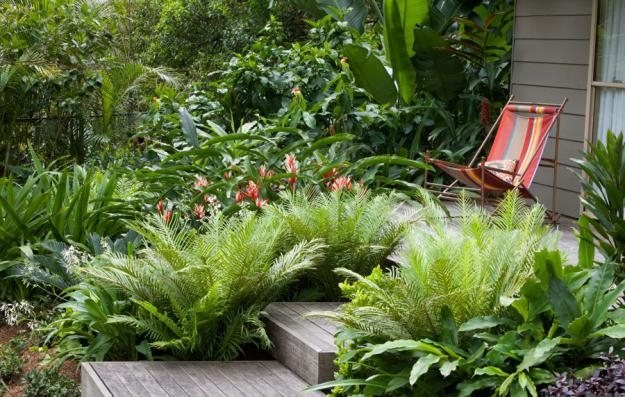

Preparing a fern for winter
Such species as bracken or ostrich are hardy enough and do not need additional shelter. Heat-loving varieties in the fall are sprinkled and sprinkled with a layer of mulch. You can use straw, wood chips or wood shavings. At the end of the season, the leaves (fronds) die off and take on a not very attractive appearance. It is not at all necessary to remove them, in the spring the fresh greens will clog the withered parts of the fern, and it will regain its decorative beauty.
Every 3 years, when there are significantly more dead parts, the plant is transplanted. Having dug out the bush, the old leaves are removed, and the root system is carefully divided into parts. The procedure is carried out in early spring, before the fern has time to start growing. With this method of reproduction, planting and caring for a fern is carried out in the same way as when growing young seedlings.
Fern in landscape design
This plant, although it may be very low, still has a fairly sprawling root system. This is important to consider when planning plantings in landscape design, because all flowers planted next to them must be combined with such a planting.
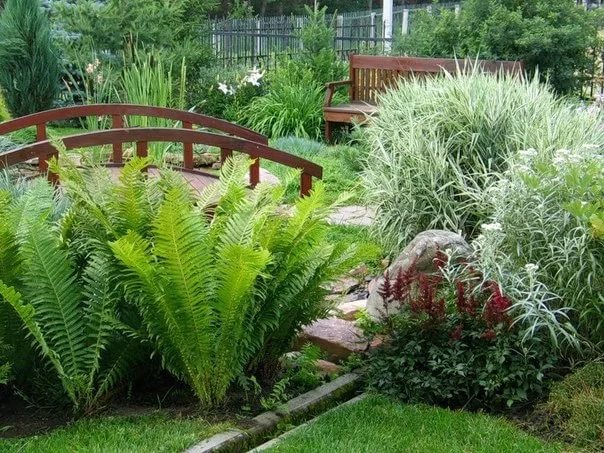

With the help of various fern varieties, you can also create rutaria, rockeries, as well as plant them along the edges of a stream or pond, if they are on your site. They are able to create a good composition with other plants that are used to decorate the reservoir: lilies, stretolists and others. Also, when planning and planting, you can use different varieties of ferns. After all, they differ not only in the shape or size of the leaves, but also in their shade.
LiveJournal
Pros and cons of growing ferns
Its beautiful foliage and ease of care have made this plant very popular with flower growers. The main advantages of ferns are:
- unpretentiousness;
- frost resistance;
- shade tolerance.
The main disadvantage of ferns is that they grow very quickly, filling everything around and displacing other plants. To prevent your site from turning into fern thickets, its growth must be controlled and limited.
The disadvantages, perhaps, can be attributed to the fact that on the sunny side of the site the fern is unlikely to please you with its appearance: most varieties in the sun become shallow and pale.
How to prune your home fern. Problems of growing a fern at home
Having planted a home fern, you need to understand that only high-quality home care will minimize its diseases and will guarantee that pests will bypass a healthy and strong flower by the side.One of the causes of diseases and weakening of the fern is violation of the rules of watering.
Many growers note: at some point they found that the leaves turn yellow on the flower or brown spots appear on them. In this case, the destructive process begins from the edges, and gradually the entire sheet disappears. But do not confuse the disease with the natural process of dying off old leaves.


Improper watering can also provoke the appearance of a nematode in the ground. In this case, only a transplant and a change of soil will save the plant, and even then not always. The insect settles in foliage and rhizomes, so it is extremely difficult to get rid of the fern from it. One of the drugs-helpers in the treatment of this pest is a solution of the drug "Ateplik".
Unsuitable, too dry air can cause the appearance of aphids, thrips, scale insects. As a prophylaxis against these pests, you need to regularly spray the plant. If an infection has occurred, you can try to spray it with a solution of "Karbofos" or the same "Aktelika".
Important! Do not confuse the process of dying off old foliage with fern disease or the action of pests on everything, including very young leaves.
Abundant sunlight can cause foliage to appear faded in combination with brown spots. The pallor of the leaves will indicate, on the contrary, about its lack or lack of plant nutrition.
Poor growth is most likely due to a small pot, and blackening and decay of foliage will appear due to a fungal infection of a plant such as indoor fern. A photo published by amateur flower growers and professionals on the Internet will allow you to more accurately determine what exactly your flower is sick with.
Fern species
Modern ferns, like their prehistoric ancestors, prefer humid and warm climates. For this reason, they are most common in the tropics and subtropics. However, even in the middle lane, the plant feels good. Although, unlike the southern territories, among our ferns there are no tall tree-like varieties - only herbaceous plants.
The following types of ferns are most commonly used in horticulture:
Female kochedyzhnik
Its other name is female fern. The leaves of the plant reach a height of 1 m. From the outside they seem light, almost weightless, thanks to the openwork wai pattern. Due to the large size of the bush, it is better to plant in places protected from the wind.
The plant is very hardy. Prefers shaded areas. Loves moist soil, can even tolerate excessive moisture. For this reason, it is suitable for planting in low-lying areas. It can grow in one place for more than 10 years.
Hairy bone
A very interesting type of fern with a specific smell. A distinctive feature of the plant is the stem of black or brown color. The height is small - 10-35 cm.
In the wild, it is most often found in rock crevices. Perfect for rockeries and rock gardens.
The hairy bone is used in medicine. It is used as an expectorant, sedative, laxative and other remedies, as well as against hair loss.
Orlyak ordinary
One of the most common fern species. It is absent only in the Arctic and dry places of the planet - in deserts and steppes.
The largest specimens can reach 1.5 m in height. The average size of these plants is 30-100 cm. The common bracken feels best in partial shade, but it can also grow in open places. Prefers light and infertile soils. Thanks to the powerful rhizome, which lies at great depth, it multiplies easily. There are states where this plant is considered a weed.
In some countries, it is used in cooking. Young shoots or leaves of the plant are eaten. They are fried, salted, pickled, used for salads.
Bracken is widely used in folk medicine for healing wounds, treating coughs, rheumatism, etc.
Male shieldworm
Male fern is the most common fern in the middle lane. And on the planet, it can be found almost everywhere: in the tundra, and in the Arctic, and in the Mediterranean, and in Greenland.
Prefers shade and partial shade, but also occurs in open areas. Grows best in slightly acidic soils. It has a rather delicate rhizome, which is very difficult to recover after injury.
As a medicine, thyme was used in Antiquity and in the Middle Ages. For treatment, a rhizome is used, which is generally poisonous. For this reason, all medicines prepared from the male thyme can be used only after consulting a doctor.
Common ostrich
The species got its name for the leaves, similar in shape to the feather of an ostrich. In addition to the official one, it has more than 10 different names. Distributed in North America, Asia and Europe.
The ostrich prefers shady places. Loves moist soils, but does not tolerate waterlogging. Plant height ranges from 1.5 m in Europe to 4 m in Asia.
The plant has two types of leaves: sterile and spore-bearing. Fertile (spore-bearing) are located inside the plant, they are smaller and differ in color from sterile leaves: at first they are light green, and then they turn dark brown. For the winter, sterile leaves (their main function is photosynthesis) die off, and spore-bearing leaves remain for the winter. In the spring, ripe spores pour out of them, which give life to new plants.
The leaves and rhizome of the ostrich are used in medicine.
Do I need to prune the fern for the winter.
In summer, they decorate our gardens, and closer to frost, their gorgeous foliage dries up. What to do with it? Send it to the compost, to the fire? Not! Fern "tops" are needed for completely different purposes. Do this at least once and check what happens. The result will surely please you
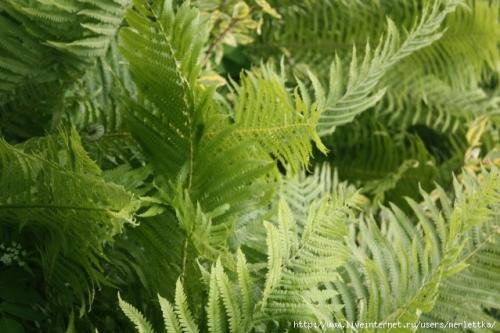

It's about the fern, which is called the ostrich. Spectacular, lush, it is rapidly gaining popularity, especially among lovers of natural gardens. Have you already got one? It remains to get along with him. Now is the time to find out what to do with it at the end of the season.
If you haven't trimmed the ostrich yet, great. By the way, these are not leaves at all. Their more correct name is wai, or flattened. Now to get down to business, crush each leaf down and place it on the ground. Try not to cover the fern only (as well as neighboring plants), cover only bare soil with leaves.
What's the point? If the winter is frosty and snowless, ostriches will winter better. Especially the largest ones, they just often do not wake up after wintering.
Will there be a lot of snow? Dry leaves will be useful both in spring and summer. After all, this is an excellent mulch! There will be fewer weeds next season, and then they will almost completely disappear. Gradually overheating leaves will make the soil more fertile. And you won't have to fertilize the green beauties, they will feed themselves. The soil will retain moisture for a long time in the summer after rains and watering. Gorgeous thickets are provided!
Here are a few more secrets of proper ostrich breeding. Plant it immediately in its permanent place. He tolerates a transplant well, except that in the summer heat he can be depressed. But after transplanting, its underground shoots will probably remain in the old place, from which new "ostriches" will then appear. Do you need it? If the ostrich turns into a weed, it is not easy to exterminate it.
Where is the best place to plant? In the shade or partial shade, but not under the water-grain trees (birch, pine, etc.). There the ostrich will be small and inconspicuous. But next to large thujas, on the north side of old apple trees or in the shade of a building, it grows perfectly.
A group of ostriches is good in itself. You can include these ferns in the shade bowl boarder too.But choose your neighbors carefully, only from plants that can withstand the onslaught of this green miracle with an assertive character. Large hosts, butterbur (another spectacular giant) and the simplest varieties of aquilegia will do. Its flowers look incredible in the lacy fern thickets!
general information
Fern is the general name for a group of spore plants, mostly similar in appearance, but having many varieties and varieties. They differ from each other not only in shape and size, but also in life cycles, and characteristic structural features, and ecological plasticity.
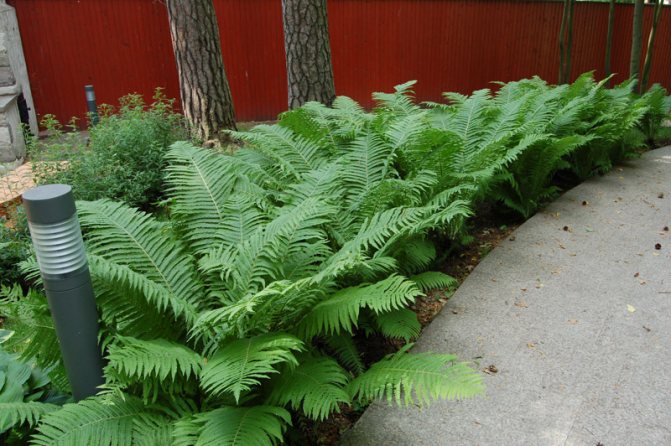

They grow in any climatic zone, but for planting on a personal plot it is better to choose the "indigenous people" of the same region. This will allow them not to create special conditions for their maintenance and acclimatization. Moreover, almost all types of ferns are decorative and attractive.
Did you know that ferns are much older than humans? At the moment, there are approximately 300 genera of this plant! In ancient times, they looked more like trees with a huge spreading crown. Today you can find both dwarf species from 3 cm and tropical giants several meters high.
Growing a garden fern: planting and care features
Many people know about the plant called "fern". It gained popularity thanks to the legend about the Kupala night, in which the fern supposedly blooms. The one who finds such a flower will smile with happiness. We will not vouch for the reliability of the legend, but we can say for sure that the fern is a magically beautiful plant, with which it is easy to decorate any courtyard and garden. The main thing is to love the fern and know how to plant it correctly. But no one has ever seen a flowering fern, at least there is no official confirmation of this phenomenon. But this circumstance does not prevent the plant from being among the leaders among many elements of garden decor.
There are about 10 thousand varieties of fern, which makes it possible for every gardener to choose the variety he likes. Let's take a closer look at the features of this plant and answer the question of how to grow a fern in the garden.
Did you know? The fern is rightfully considered one of the most ancient plants, since it appeared on Earth several million years ago.
Overview of species
There are several types of winter-hardy fern that will perfectly take root in the gardens of the middle lane and do not require additional care:
- Female kochedyzhnik... The height of this variety reaches a meter, and it lives in one place for about 10 years. It has a beautiful spreading crown.
- Orlyak ordinary... The variety is slightly less tall - up to 80 cm in height, but it has a very decorative look, and the roots are often used for medicinal purposes.
- Male shieldworm... The height of this plant reaches 1.5 meters, although the growth rate is low. Reproduction of such a giant is quite simple - by dividing the rhizomes. Further care is common for all ferns.
- Common ostrich... It grows rather quickly and gives beautiful thickets of emerald color. This variety can be placed in an area with more intense lighting.
- Asplenium... Many people know him as Kostenets. When choosing this variety, remember - there are thermophilic varieties, and there are frost-resistant ones (withstand up to 18C frost), be guided by the temperature regime of your region.
- Nested asplenium... It grows in tiny spaces - in old snags, heaps of last year's foliage and trunks, while it can reach a meter in height. For landscape design, just a godsend! Dwarf varieties can be found in specialized stores.
- Onion-bearing asplenium... This type of fern with a height of about 60 cm is native to New Zealand, which means it is quite thermophilic. For the winter, it is better to properly cover it with a special material, and on top - with dry foliage.If the winters in your area are cold enough, it is better to dig up the plant altogether and put it in a cellar until spring.
Home care
Caring for indoor ferns is easy. Like any other indoor plant, it requires a certain soil, a suitable location in the apartment, watering and spraying. Not complete without periodic fertilization. In addition, you should know the features of a flower transplant, since this must be done every year due to its rapid growth.
Ground requirements
The plant prefers loose soil with a lot of leaves and humus. Sometimes peat or needles may be present in it. The ground should be very loose, airy. Through it, water will easily flow to the roots.
The roots of the plant can rot from overflow, so the pot needs good drainage.
Prepared soil can be purchased at the store or prepared by yourself if you have sufficient skills for this.
For cooking, you will need to take in equal proportions:
- sod land;
- peat;
- leafy ground.
You should also add some humus and sand. This recipe is most suitable, creating the very soil conditions required by the indoor fern.
An earthen pot is most suitable for keeping nephrolepis. It tends to collect excess moisture from the soil, and then give it away as needed. This nuance helps to control the moisture content of the earth.
However, clay tends to become covered with fungus, which is very difficult to remove later.
Plastic containers are fine too. It should be remembered that this material does not allow air to pass through and does not have good resistance. In order for the plant to feel great and not fall off the surface, it is necessary to choose a stable and large pot. Its diameter in diameter should be 2 times less than the size of the flower crown.
Lighting and temperature control
The leaves of nephrolepis are large and green, so their need for a large amount of diffused sunlight is quite logical. The plant can tolerate shade, but it will not look so impressive.
Direct rays of the sun will scorch the sheets, leaving brown spots on them. Therefore, it is better to place the fern near the window, but not on the windowsill.
The optimum temperature for keeping is 15-22 degrees. It can be warmer in the room, especially during the heating season, so during this period it is recommended to moisten the leaves more often by spraying. The minimum temperature at which an indoor fern can survive is 5 degrees.
Watering and spraying
Water the fern with soft water, slightly warm. In the summer season, this can be done 2 times more often than in winter. Otherwise, in winter, the plant will continue to grow and will be too elongated with small leaves, since there is not enough sunlight.
Watering should be such that the soil in the pot remains slightly damp. Excess water, like drought, are not the best conditions for indoor ferns.
Spraying the leaves should be done daily, especially during the heating period. Excessive dryness of the air is not suitable for nephrolepis. You can also take care of a suitable indoor humidity. To do this, it is recommended to purchase a humidifier or regularly hang a wet towel on the battery. Such a microclimate in an apartment is useful not only for a flower, but also for people.
It is better to take distilled water or rainwater, as tap water will leave white spots on the greenery.
Top dressing and fertilization
It is recommended to fertilize indoor fern in spring and summer. This can be done using any ready-made feeding solutions. They must be diluted according to the instructions on the package. Then add the same amount of pure water to the resulting solution.This feeding option is most suitable for nephrolepis.
How to transplant?
One of the main steps in caring for a green flower is its transplant. It is required to carry out it every year, since the rhizome of the plant grows rapidly. The crown also grows larger, which may make the previous pot unable to support its weight. Choose a new container 2-3 cm larger in diameter.
To transplant a room fern, you will need:
- Gently holding the flower by the base, pull it out of the container along with an earthen lump.
- Shake some of the old soil from the rhizome. If there are decaying roots, they must be removed.
- Place the plant in a new container, cover the surface with fresh earth.
It is best to transplant in the spring. If this is done at other times of the year, the indoor fern will take root for a long time and look not the best.
Seat selection
Ferns are unpretentious, but this does not mean that they will grow anywhere. But their requirements are exactly the opposite of the conditions that the main horticultural crops require - instead of the sun, they need shade, instead of moderate moisture, they need constant high humidity.


But, by and large, they do not need fertilizers at all. They are not demanding on the ground. For planting, you should choose a shaded and always wet place. It should be borne in mind that different varieties tolerate waterlogging or, on the contrary, a lack of moisture in different ways.
Direct sunlight will not do any good to the plant, rather the opposite - the plant will be stunted, stunted and, most likely, will get sick in the near future.
Popular types
This plant has more than 10,000 species, so when decorating their garden, summer residents have a wide choice. There are ferns growing on trees and on the ground.
The most common types of this plant include:
- Common ostrich... The plant can be seen in many parts of the world, it is called so because of its feathery leaves, resembling an openwork pattern of ostrich feathers, reaching 1.5 m.With the onset of spring, the fern foliage is rolled up in the form of a cocoon, with warming it opens and turns into a magnificent cone ... Its vertical root system requires it to be periodically loosened and mulched in the fall. This most spectacular perennial species forms lush thickets.
- Have common bracken height reaches 70 cm, it grows well on dry and "poor" land. The horizontal long leaves of the plant resemble an eagle's wing. It is dangerous for pets due to the presence of toxic substances; it will not harm a person.
- Female kochedyzhnik... The plant is characterized by dissected leaves, collected in bunches. Under natural conditions, it forms hummocks in swamps. The size of the plant will depend on its variety (30-70 cm), the root system is thick and short. It is able to grow without transplanting to another place for more than ten years.
- Male shieldworm... In nature, it grows in the forest in a shaded place, reaching a height of 30-150 cm. Spores appear on the lower side of the leaf, they, like a shield, are covered with kidney-shaped veils.
In the photo, the common ostrich
The listed garden fern species are frost-resistant plants and do not need shelter in winter.
Tropical fern species are best grown indoors.
Heat-loving fern species, such as golokuchnik and Linnaeus, require protection from the cold in winter.
Reproduction methods
The fern is a unique plant - it has neither sex, nor flowers, nor seeds. Reproduction occurs by spores, which are fixed on the underside of the leaf in small numerous tubercles.
Disputes and division
This path is possible for amateur gardeners, but it is quite long and painstaking. To do this, ripened spores with leaves are cut off in the fall, and in January they are sown in prefabricated soil (2 hours of peat, 1 hour of leafy soil, 1 tsp.sand), without burying them, but placing them on top and moistening from a spray bottle. Glass is placed on top of the ground. In the 2nd month after planting, the first shoots will appear. If you want to deal with varieties with long rhizomes (ostrich, bracken, etc.), then the breeding process will be much easier - in early spring, divide an adult bush and, after removing the threat of repeated frosts, plant it in the ground.
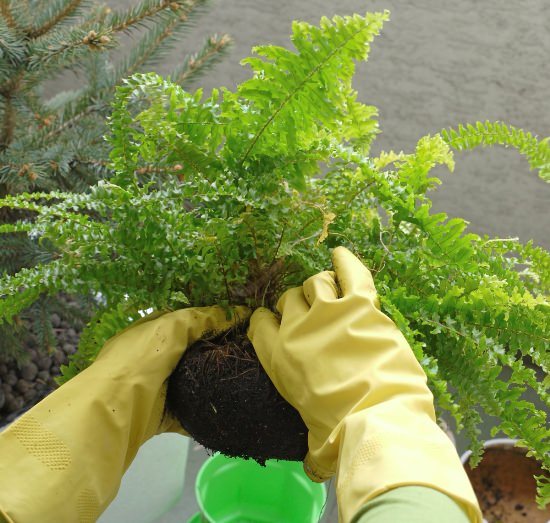

Rhizome mustache
There are types of ferns (nephrolepis exalted, heart-leaved) that have rhizome whiskers. They are terrestrial and give young shoots easily. It is enough to dig them in to a depth of 5 cm and water well.
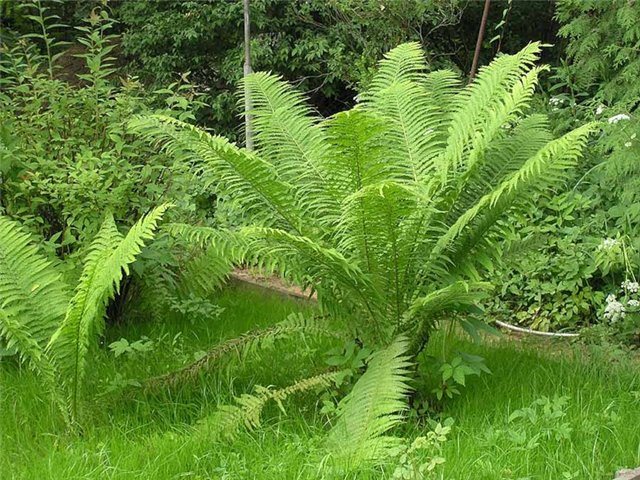

Brood buds
In species such as kostenets and mnogoryadnik, there are brood buds, which also produce offspring, if they are separated from the leaf and placed on peat under glass.
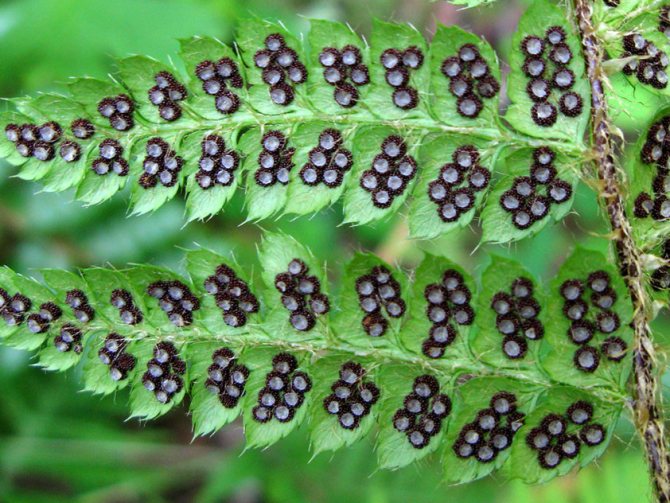

Ready bushes
This is the easiest and most common method without much hassle. It is enough to dig a fluffy and healthy bush that you like in the forest, wrap the roots with earth so that they do not dry out during transportation, slightly moisten the plant itself, and at home divide it and plant it in place.
When planting large varieties, leave a sufficient distance to neighboring plants, otherwise the fern will easily “press” them!
What is the best time to replant a garden fern?
The garden fern greatly adorns the garden with its bright, cheerful greenery. He is quite unpretentious. The only thing that he can hardly bear is the southern slopes without any shade. The best place for a fern is shade and partial shade. If the sun looks in there in the morning or at sunset, this is great for the plant.
For many years, a fern has been growing in my garden, handed it out to friends and acquaintances, was accepted by everyone. What is the best time to propagate? Let's just say: at the peak of the heat, that is, June-July, do not move the fern from its place. An exception may be cases when it is necessary to forcibly vacate the territory, dig a cable, etc. Then cut off the leaves, leave a little and plant in a place protected from the sun, water.
You can transplant the fern safely in April-May, and then August-September is also favorable for transplanting. Remove the leaves, leave no more than two and they can be shortened. Choose a land that is not heavy. If it is, then add drainage.
The first year after (from spring to autumn) transplantation, the fern does not give new shoots. If it turns green, gives leaves, that is success. From the second spring of life, the fern again does not give visible growth points, only the leaves will increase. But in the second year, the fern actively grows roots and underground shoots. But in the third year, you can get ten points of growth at once, ten new green funnels-shoots, which will dissolve the beautiful green "peacock tails" of the fern.
- VERY IMPORTANT
You can no longer weed with a hoe and dig with a shovel near the fern. There are roots-shoots everywhere, they are very superficial. Have planted a fern, pull the weeds around it by hand. Just don't weed with a hoe !!
Transplant the fern boldly, and wait for the third year - this is the bloom of your flower bed. Then it will creep in by the roots, as the lily of the valley does.
This year was hot, and in addition to everything, we had to cut down the apple tree, which shaded the fern. At the peak of the heat, the leaves seemed to be burnt, curled up. I cut them off - the flowerbed began to produce too depressing impression. But the rains came, the heat subsided, and new lettuce leaves of the fern grew, as if it was spring again. Maybe if I watered them abundantly in the heat, the old leaves would also survive.
In the photo, my fern re-grown after a drought.
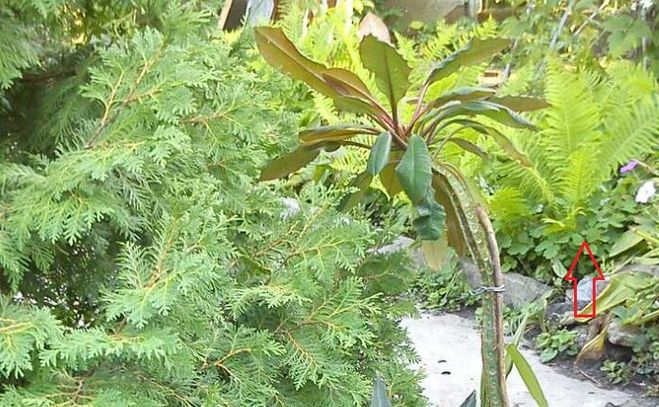

Landing
Before planting, decide on the size of an already adult plant and, accordingly, prepare a planting hole for it. The diameter of the hole for large varieties will be about 50 cm, the depth is at least 40. It is best to fill it with the same soil in which the bush grew before transplanting - this will greatly facilitate its survival.To do this, do not be too lazy to take some forest land with you.


If you bought a ready-made plant grown in a nursery, be sure to add peat when planting and do not be zealous with fertilizers. The fern doesn't like that. Water the new settler immediately.
Despite the fact that the culture is considered unpretentious, one should be very careful with the seedlings when transplanting: do not allow the roots to dry out, the leaves droop, try not to touch them at all during work.
At the end of all actions, it is imperative to mulch the soil with sawdust or old grass. This will keep the moisture you need.
Landing conditions
It is important to decide on a place for the fern before planting. Gardeners consider shaded areas to be the most suitable. The soil should not be too heavy and well moistened.
These parameters will create ideal conditions for growth. If you plant a fern in a sunny place, it will not reach the required size and will be weak. A well-chosen place and proper care will allow you to grow a beautiful plant.
Fern practically does not require fertilization. It can be safely planted in the area where other flowers do not take root. For giant species, leave up to 30 cm between the holes for planting. This distance can be either increased or decreased.
In the photo, planting a fern
When planting, pay attention to whether other plants will interfere with the fern's growth.
If it has extensive roots, then it is better to provide for a spacious area, as well as put stops for the growth of roots, decorated under an ordinary fence.
When the planting site has already been chosen, it is necessary to prepare the soil and the plant itself for planting. The fern is also planted in the fall; before planting, a pot with a rhizome is placed in the hole.
After the air bubbles disappear, you need to pull out the root and plant it in the ground. The well is also moistened before planting. Make sure that some soil remains on the rhizome, in which the plant previously grew. If the plant grew at home, the soil is taken from the pots, if in the forest, then the soil will be forest.
By choosing the right soil, you "help" the plant to take root faster. It is better not to touch the foliage so as not to disturb the decorative appearance of the fern.
Having spread the roots in the deepening, it is necessary to cover them with earth and water them with water that has settled. Plants in pots, planted all year round.
Care
In conditions of insufficient rainfall, systematic watering is important. Improves plant health and occasional shallow loosening. There is no need for pruning (except for broken or diseased leaves). Old, wilted foliage will serve as fertilizer for future generations.
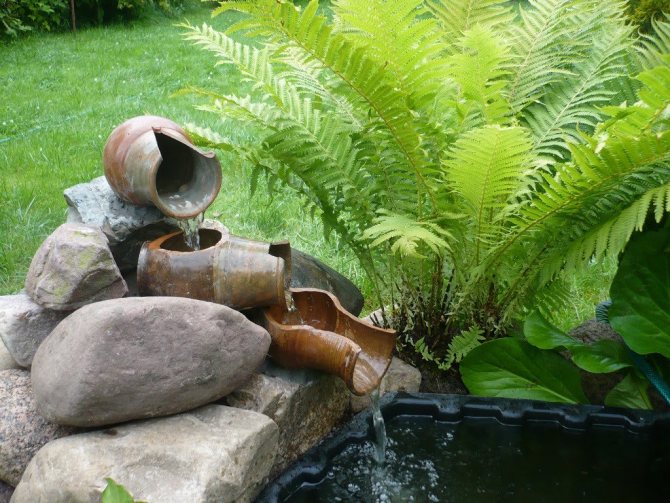

Top dressing is optional, but if you wish, you can add it to do it better at the beginning of growth, in the spring.
Ferns are more responsive to liquid fertilizers.
How to care for a plant
The garden fern belongs to unpretentious plants, it is easy to care for it. The plant requires abundant watering, mulch, that is, it must be sprinkled at the base with sawdust or stale foliage by 3-5 cm.
It is especially recommended to sprinkle it with sawdust or stale foliage in autumn, because then you will protect the fern from the cold and from pests. In the spring, this “blanket” will be a good fertilizer for fern plants. Young shoots will be able to break through this cover.
With its beauty will amaze
garden rose hips: planting and care
for a bush in a summer cottage, breeding methods and other subtleties of cultivation in the material of our site.
Here you can find a drawing of a sliding gate for making with your own hands, as well as a step-by-step master class with detailed photos.
Pruning tips
Such plants do not need pruning even in autumn and spring. This is because the leaves cover the ground, providing additional protection. They dry up by spring and can be used as fertilizer.
Shoots that are broken or affected by a disease need pruning to prevent it from spreading.
Top dressing
Ferns do not need to be fertilized. But fertilization provides plants with useful minerals and also promotes good growth. Ferns are usually fed with the onset of spring, as well as the appearance of the first shoots.
If you notice withered, dried, or yellowed leaves, you don't need to repot the plant right away. Perhaps he lacks nutrients, so any kind of mineral fertilizer should be purchased.
It is better if it is liquid, then when watering it will be easy to add to the soil.
During a drought period, you need to increase the watering rate, which will prevent leaves from wilting. Also, plant care can be supplemented by loosening. To do this, you need to have special devices, but you should not deepen it much, so as not to damage the large root system of the fern.
Preparing for winter
In winter, only heat-loving plant species are sheltered, such as golokuchnik, shitnikov and others. Protect from cold in those regions for which cold and long winters are characteristic, using peat and dry leaves for this.
If the plant is not frost-resistant, it is covered with a film on top, covered with leaves or spruce branches are placed on top.
How to choose a place on the site for a garden fern
Lovers of this plant should know how to properly plant a fern.
First of all, you need to understand that all species of this plant, without exception, love shade and moisture, so the garden fern has its own specifics of planting and care in the future. If your dacha has secluded darkened places where other plants feel uncomfortable, you can plant a fern there.
It easily tolerates conditions that are destructive for other representatives of the flora and can grow in soil without fertilizers.
The depth of the hole and the distance between adjacent bushes are determined from the size of an adult plant. If you are planting long-rooted fern species, set aside more space for them, as they can greatly pressurize neighboring plants. You can also artificially limit their area.
Does fern need lighting
The fern tolerates shade well, but a long absence of sunlight can be bad for the leaves - they turn yellow and fade over time.
This does not harm the plant, but its appearance deteriorates. The best lighting for a fern is diffused sunlight. Direct rays of the sun should not hit it.
Read also: Bonsai tomatoes growing on the windowsill
What should be the soil for planting
To the question: what kind of land do ferns love, it is easy to give an answer even to a novice gardener.
Of course, the soil should be loose and absorb moisture well. So that the water in the soil does not stagnate and does not provoke putrefactive processes on the roots, you will need river sand or other drainage.
Add peat and sand to the excavated soil in a 2: 2: 1 ratio. Moisten the hole well and carefully place the plant in it. As much soil as possible should remain on the roots of the fern, in which it grew before transplanting. This will help him quickly settle down in a new place.
Fern growing techniques: secrets and nuances of care
You don't need to take special care of the ferns, but you should pay attention to it occasionally. Wet soil, shady areas, and top dressing will help you grow a beautiful fern in your garden.
Fern watering
Wet soil is perhaps the main condition for the fern to grow normally. In the first months after planting, water the young plant regularly and abundantly. The plant also needs a large amount of water in especially dry summer seasons. During watering, you can sprinkle fern fronds.
Loosening and mulching
After each watering, be sure to loosen the soil around the plant.This will make it looser and lighter. In parallel, you can remove weeds that interfere with the full growth of the fern. After loosening and watering, the soil around the plant must be mulched. This will prevent excessive evaporation of moisture and also reduce weeds. Spruce needles or paws can be used as mulch, which are also beneficial for the fern root system.
Fern feeding
There is no particular need for fertilizers when growing various types of fern, but a small amount will not harm them. It is best to use liquid fertilizers and solutions during the period of active vegetation and growth of wai, as well as during the formation of offspring. Complex mineral and organic fertilizers can be used as fertilizers.
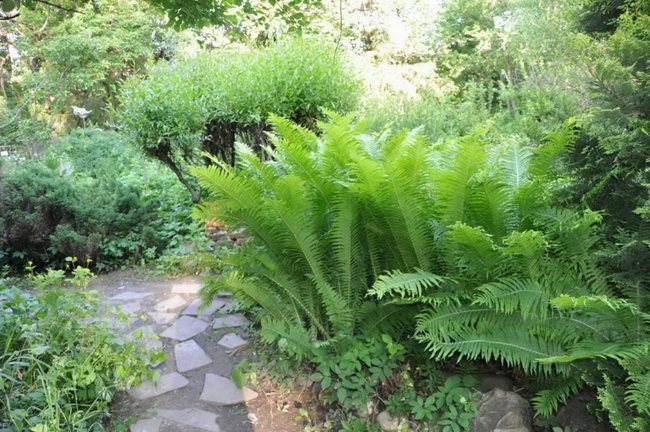

Fern renewal
Once every 1-2 years, ferns must be thinned out, as they grow and proliferate very quickly. Usually old and damaged sockets are removed. This should be done in the spring and very carefully. Thus, you can simultaneously engage in the reproduction of this plant.
Preparing for winter
Many species of fern thrive in our winters, but there are ferns that are sure to cover with the onset of frost. First of all, the soil around the plant must be mulched with straw or fallen leaves. Then carefully cover the entire bush with a layer of straw, on top of which you need to stretch the covering material.
Care features
In order for the plant to develop normally, it needs to be provided with full and high-quality care.
Watering mode
When growing a fern in the garden, it is worth monitoring the timely moistening of the soil. Watering should be regular. It is carried out every 5-7 days. With the arrival of autumn, the frequency of watering is reduced, since at this time the plant does not require a large amount of moisture. Excess fluid provokes stagnation of water, which leads to rotting of the root system.
When watering, it should be borne in mind that not only the root system of the culture needs liquid, but also its leaves. Therefore, it is so important to spray the entire plant.
Preparing for winter
Forest fern does not need special preparation for winter. When growing a thermophilic crop in a region with a harsh climate, certain recommendations will be required. In late autumn, the culture should be covered with old leaves, peat or spruce branches. Usually, only some varieties need insulation - mnogoryadnik, kochedyzhnik, maidenhair.
Loosening and weeding
It is recommended to loosen the soil periodically. This will help provide the root system with oxygen and nutrients. Timely weed removal is of no small importance.
Transfer
It is recommended to move the fern in the spring. However, sometimes this procedure is allowed to be performed at other times - for example, in the summer. The bush should be dug out very carefully so as not to provoke damage to the root system. There should be a lot of soil on the roots. After transplantation, the culture should be watered with high quality. It is important to take into account that the soil always settles. Therefore, a shallow hole is required for culture.
It is recommended to put a plant in it and correct its position. The top of the fern should be at ground level. Then the plant should be thoroughly watered and immediately covered with earth. This will help to avoid the appearance of an air gap and strengthen the root system with soil.
Breeding features
The fern reproduces by dividing the bush and spores that form on the back of the frond.
Dividing the bush
When carrying out a transplant, the bush is divided, in which:
- The day before the procedure, the area around the fern is moistened.
- An adult plant is removed from the ground and divided into several parts, each of which must have at least one apical shoot.
- The plots are planted in prepared holes and covered with a substrate, after which they are abundantly watered.
Reproduction by spores
You can get new plants by sowing spores in early January as follows:
- A plastic box with drainage holes at the bottom is filled with a calcined substrate with a 4 cm layer of sand, peat and leaf earth in a ratio of 1: 1: 2.
- Spores are distributed over the surface of the soil.
- The container is covered with cellophane and moved to a warm, bright place, where bottom watering is organized for the crops.
- After emergence, the cellophane is removed.
- At the end of winter, the plants are transferred to the greenhouse, from which they are transplanted into the open ground after the onset of stable heat and the disappearance of the threat of return frosts.
How the plant is used in landscaping
The plant can be dwarf (no more than 3 cm), and large, reaching the size of a tree. But even a short specimen has a spreading root system.
Landscape designers take this factor into account when planting other plants nearby. They must be matched in size, it is then that the fern will stand out favorably among them.
At the summer cottage, the plant will always find its place
Using this plant, gardeners create wonderful landscape compositions from its different varieties, combining various shapes and color shades. If there is a reservoir on the site, the fern will look great near it in a composition with other flowers (lilies, arrowheads).
Marsilia fern can be planted in water at a depth of 50-70 cm. Its delicate leaves will add charm to the water surface. The plant will perfectly decorate an alpine slide.
On the site, a fern is planted on the northern, shady side, since it does not tolerate temperatures above 25 degrees badly. For example, they can decorate the walls of a house.
Some of the plant species have medicinal qualities that can be used in cooking. For this, young shoots of the plant are used, which are boiled for 10-15 minutes before use.
The less growers disturb and transplant ferns, the more luxurious they grow.
The garden fern, planting and caring for which is not difficult, is an excellent culture that gives a finished look to any landscape composition. The representative of the department of vascular plants, which witnessed the life of dinosaurs and other extinct species of flora and fauna, is loved by many gardeners and gardeners.
Preparation steps before planting a fern
Although the fern is considered an unpretentious plant, however, in order to obtain a beautiful and decorative garden decoration, you must carefully prepare before planting. It is important to purchase high-quality and healthy fern seedlings, as well as choose a place suitable for the growth of this plant on your site.
Stage 1. Selection of planting material
- First you need to determine what kind and variety of fern you want to purchase. Lower varieties of this plant are ideal for decorating rockeries, mixborders, alpine slides. Tall ferns look great as tapeworms and central figures in garden compositions.
- The next step is to determine how to obtain fern seedlings. You can grow seedlings from spores yourself or by dividing a bush if you already have this plant on your site.
- If you do not have such an opportunity, you can easily buy fern seedlings.
- Purchase planting material only in specialized stores or agricultural firms that are professionally engaged in plant breeding.
- Foliage saplings are usually commercially available. Therefore, when buying, pay attention to the condition of the foliage, its color. There should be no stains or visible damage. The leaves should be about the same length. There should also be no dry parts.
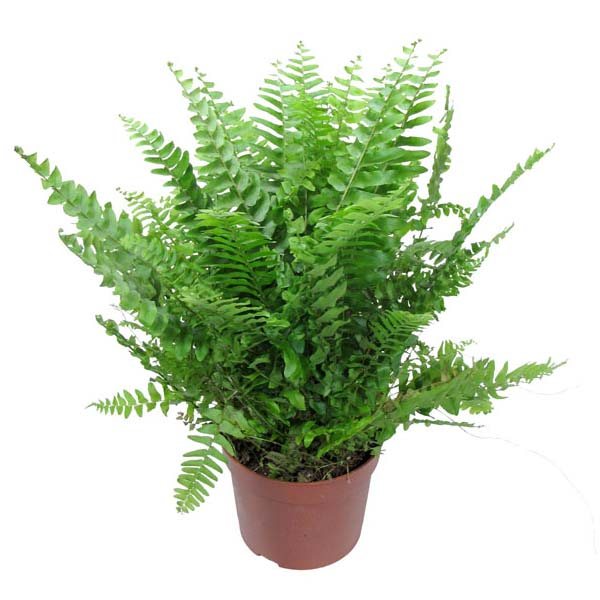

Stage 2. Choosing a landing site
A correctly chosen place for planting a garden fern is the key to the successful growth of this ornamental plant.
- First of all, you need to find a shady place for this plant, but if possible, a shade with small glimpses of the sun will be better. For example, a fern can be planted near a large garden tree.
- Remember that ferns don't like strong winds and drafts at all.
- Alternatively, the fern can be planted along the north side of the house or other buildings.
- A great place to plant a fern is along shaded ponds or ponds.
- For these plants, the presence of fallen trees or stones on the site is ideal. This way you can create a unique composition.
Stage 3. Selection and preparation of soil
The fern is considered a plant that is unpretentious to soil, however, for full growth, you still need to provide an optimal composition. Ferns are best planted on loose and light soils. In doing so, remember that the soil should be well moistened, but the water should not stagnate. This can cause the fern roots to rot. Therefore, clean river sand must be used to drain the soil.
Ferns grow very quickly and strongly, so you can bury about 20 cm of slate around the perimeter of the selected area in advance.
Garden ferns: care
Garden fern is an undemanding crop, so taking care of it will not cause much trouble for the gardener.
Watering and soil moisture
One of the main parameters is soil moisture, which at the same time must remain loose, preventing water from stagnating. During the period of active growth, the fern is watered to maintain the required moisture level. To retain moisture for a longer period, the area around the plant can be mulched.
Top dressing and fertilizers
Fertilization is not an obligatory agrotechnical measure. But in order to get a beautiful, lush bush, which will decorate the shady recreation areas, in early spring the fern is fed with the help of organic or mineral fertilizers.
Varieties of Eagle
To date, there are 4 main varieties of common bracken, which are found in different parts of the planet:
- common bracken - pteridium aquilinum var. feei (W. Schaffn. exFée) Maxon;
- pteridium aquilinum var. lanuginosum (Bong.) Fernald;
- pteridium aquilinum var. latiusculum (Desf.) Under. Ex A. Heller;
- pteridium latiusculum (Desf.) Hieron. Ex R.E.Fr. It is found in China, Japan, Taiwan, in the north of Europe, almost everywhere in Canada and the USA, in the north of Mexico;
- pteridium aquilinum var. pseudocaudatum (Clute) A. Heller.
Landing in open ground
When carrying out planting work, it is necessary to take into account such important points as the preparation of holes, the choice of place and time.
Site selection and soil preparation
In order for the culture to develop well, it is necessary to select a shady area with light and moist soil, where there is a lot of free space.
The fern does not need preliminary preparation of the soil if its structure is sufficiently loose. In the case of heavy soils, humus and river sand should be added when digging.
How and when to plant?
Perfectly adapting to new conditions, the fern survives when planted throughout the growing season.
When disembarking, adhering to the following algorithm:
- A hole is dug, the dimensions of which depend on the root system of the planted specimen.
- A drainage layer is placed in the pit and slightly crushed by the excavated soil.
- Next, a fern with an earthen lump is immersed, which allows the plant to take root faster.
- The vacant spaces are filled with a substrate of excavated soil, peat and sand in a ratio of 2: 2: 1.
- The soil around the plant is compacted and well moisturized.
Attention! When carrying out planting, it is necessary to carefully handle the fronds, damage to which leads to the loss of decorativeness by the plant.
What plants do ferns in the garden combine with and what diseases and pests threaten them
Due to the beauty of openwork leaves and bushes in general, ferns take pride of place in the design of the site. Photos of such compositions are very natural and beautiful.
Attention! The fern rhizome quickly spreads over the site, so the installation of limiters is mandatory.
The combination of fern with lilies and arrowhead by the pond will give the plot a special charm. On shady rock gardens, you can place low varieties next to flowering creeping plants, for example, periwinkle.
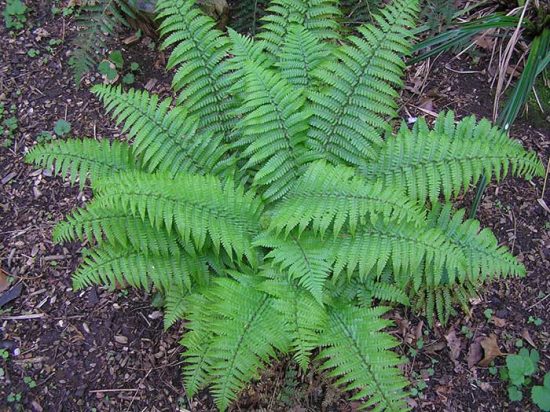

We can say that the combination of ferns in the garden is possible with any shade-tolerant plants: hosts, astilbe, ditch, etc.
The plant is not affected by diseases, if the rules of care are followed. Of the pests, slugs and caterpillars can be noted, which damage the leaves.
The fern can be called a bright decoration of a shady area that does not require much attention. Its cultivation is available to absolutely everyone, even to inexperienced gardeners.
Bracken spread
Bracken is an unpretentious plant that lives in almost every corner of the world, with the exception of the arctic and desert parts of the world. It grows in forest areas, usually in coniferous or deciduous forests that do not have a lot of light in places. Fern varieties can also be found in the steppe zone.
Places such as various hills and mountain ranges, which have light soils and darkening, are excellent for distribution. In addition, the plant easily takes root in grazing areas and fires. This feature lies in the vegetative mode of reproduction, which ensures rapid growth and deep-lying fern roots.
Fern is not common in European zones, but some people grow it in horticultural conditions. In addition, some countries consider the fern a difficult weed to control. The reason for this is good breeding ground for this plant.
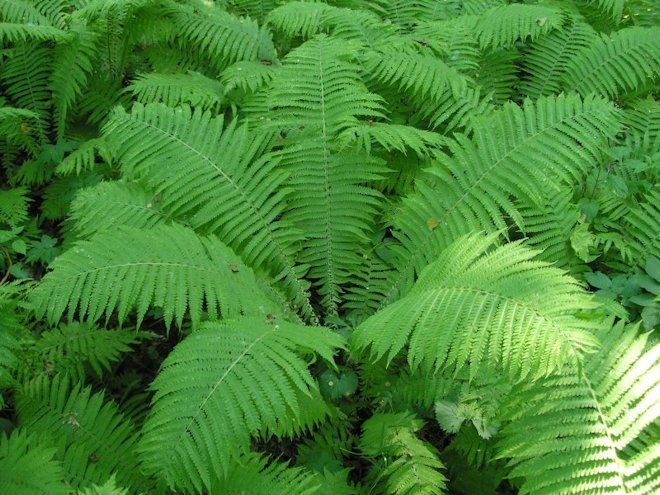

Tips & Tricks
In order for the fern to fully develop, it should be well looked after:
- water on time;
- loosening the soil;
- remove weeds;
- follow the rules for plant transplantation;
- carry out treatments for diseases and pests.
The fern is considered a very unpretentious plant that has excellent decorative properties. Today, there are many varieties of culture that can be planted in the garden. To achieve success in growing a plant, it is necessary to provide it with high-quality and complete care.
Fern Care: Secrets of an Ancient Handsome Man
In fact, this plant is quite unpretentious. The main conditions for its successful cultivation are abundant watering and mulching of the soil under the bushes.
Mulch is especially important in the autumn period, this is due to the fact that with its help it is possible to protect the plant not only from hypothermia in the cold, but also from the attack of pests.
With the onset of spring, also do not rush to remove the old "fur coat", overheating, it will serve as an excellent fertilizer for your fern. Young growth will easily break through the cover of old foliage.
Fern loves an abundance of moisture. Therefore, in dry weather, the frequency and volume of humidification should be increased. Otherwise, the beautiful foliage may wither.
But stagnation of moisture should not be allowed. Loosening will help retain moisture for longer. But do not try to loosen too deep, you can damage the branched root system of the handsome man.
Ferns do not need pruning. Luxurious leaf mass additionally protects the plant in the winter cold. In the spring, the foliage will dry out completely and turn into a kind of fertilizer. Only broken and disease-damaged stems are pruned.
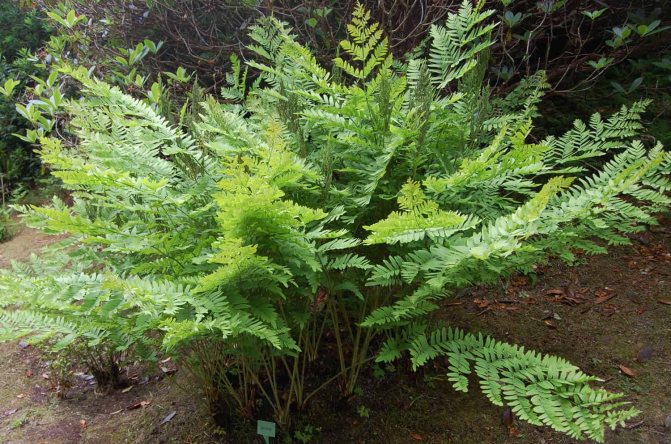

This is not to say that fertilizing is vital for ferns. Although, undoubtedly, additional nutrition provides a great appearance of the plant. It is recommended to fertilize in early spring, when the shoots are just breaking through from the ground.
Fern responds equally well to both organic and mineral compounds.Observe your plant, not always withered, yellowed or drying leaves indicate the need for a transplant. It probably just needs to be fed. Pour a liquid mineral complex over it.
Winter shelter is only necessary for some fern species that do not have sufficient frost resistance. It is also a prerequisite for regions with harsh climatic conditions.
You can cover the soil under the plant with a thick layer of peat or dry leaves. For reliability, you can cover everything on top with a film and again cover it with a layer of foliage or spruce branches.
Subject to all agrotechnical requirements, the fern is not susceptible to various diseases. Caterpillars and slugs can be the only problem. Get rid of harmful insects by hand collection.
Description of the culture, its known varieties and varieties
There are about 200 of these wonderful plants known in the world, most of which are inhabitants of tropical forests. If you look in general at the various types of ferns, then the following biological features of the plant can be noted:
- Perennial herbaceous shrub.
- Externally, the fern can look like a low grass, and a rather impressive tree size.
- Under the ground is a medium-sized creeping rhizome.
- Above the surface is a dense stem made of wired tissue.
- The culture has no real leaves. The so-called fronds - primitive leaf plates - extend from the stem. Their formation occurs in the spring in the roots.


- Reproduction occurs with the help of spores in brown bumps, clearly visible in the photo of the underside of the leaves.
- Ferns are ideal plants for shady areas.
- Planting is possible both outdoors and in flowerpots.
Attention! Growing thermophilic representatives in the middle lane is possible only in a room.
In the open ground of a temperate climate, the following species and varieties feel great:
- Common ostrich - it can be called the most common type of fern found in gardens. This species requires minimal care.
- Common bracken - young shoots of this species are eaten.
- Male dwarf - often found in the forests of the middle zone.
- Cochid fern - most of its varieties have an unusual reddish color. For example, the leaves of Burgundy Lace are wine-colored. These varieties look especially catchy in the fall.


Description of agriculture
Ferns are the oldest surviving plants on the planet. They are over 400 million years old. Agriculture has more than 10,000 varieties. At the same time, they can be so different that visually they can not be combined into one culture. The culture is unpretentious to the soil, resistant to high humidity.
In fact, the shrimp has no leaves. Those green deciduous legs, which in our time are considered to be the leaves of the fern, are its branches. Breeders are trying to develop a fern variety that will have full leaves. A similar variety was bred and named "Lesna". Anyway, it is not considered a variety that has a full leaf. There are varieties in which the form of development is herbal, there are plants with a woody form of development. All of them belong to the fern-like species.
Fern has medicinal properties and has long been widely used in medicine. Long-term use of fern infusions and extracts has shown that the plant can relieve many diseases of the gastrointestinal tract, liver, respiratory tract, etc. On the Internet, you can find many explanations about how to make an infusion or decoction from a fern leaf on your own.
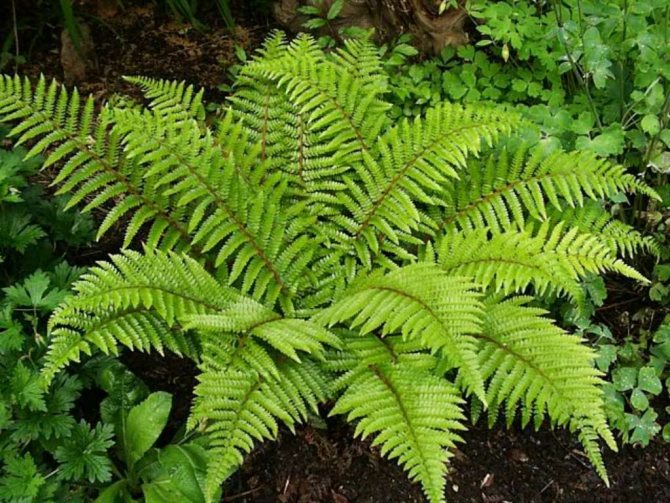

Fern
Nowadays, a fern in the country is not uncommon.Planting and caring for a fern in the open field does not differ in any difficulties. Ornamental fern or street fern will develop equally under the conditions of proper care. The plant can be planted even in the Urals, given the climatic conditions of this region. How to plant a fern, how to grow it correctly, how to protect the fern from diseases, will be discussed below.
How and when to transplant a fern?
Plant transplantation can be carried out throughout the season, but early spring is considered the optimal time, when the shoots have just begun to develop.
During the procedure:
- A pit is prepared of such a size that allows you not to constrain the straightened roots of the transplanted specimen.
- The hole is filled with water, into which a fern with a lump of old soil is immediately lowered.
- The plant is buried in such a way that the root collar rises 1-2 cm above ground level.
Application of bracken
Bracken, despite the fact that it is poisonous, is widely used by humans for medicinal purposes and as a culinary dish. The use of bracken has a lot of conflicting reviews. Therefore, before consuming and using the plant, it is necessary to consult with doctors about the beneficial properties of the product.
The bracken is widespread in use in human economic activities. The leaves are used to control pests and cockroaches. Also, silk dye is made from the contents of the bush.
Rhizomes are rich in starch content, so glue is obtained from bracken. Potash extracted from the roots is used to make glass and green soap. In addition, the roots were used as a means for dyeing woolen fabrics black.
On the farm, Orlyak was used as fertilizer and lining for livestock. Also, the leaves are suitable for feeding livestock - goats and pigs.
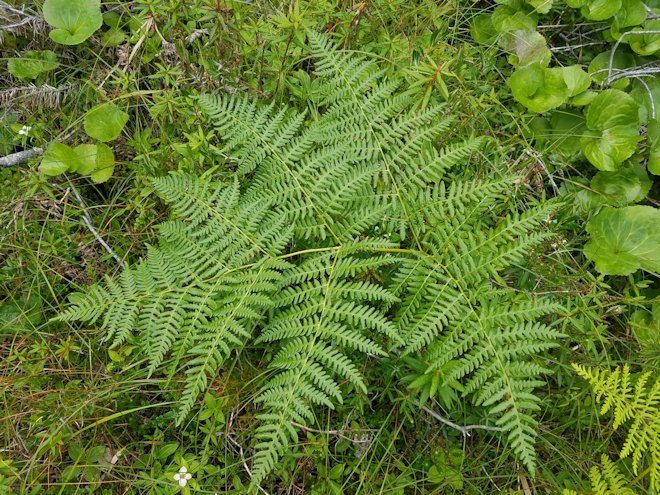

Valuable food product
Bracken is widely used as a delicacy dish. Fern shoots are eaten, which are harvested in the season of their appearance. Some people used the cooked plant instead of bread. In some regions of Russia, fern is canned and sold as a separate dish.
They eat pickled fern. It tastes like salted mushrooms or asparagus, sometimes olives. Also, Japanese chefs use this plant as a delicacy, dessert, or add to pies. The Japanese extract starch from the rhizomes of the plant, from which they prepare specialties.
It is important to understand that eating raw food is life-threatening because the acid in fern leaves is poisonous. This can lead to severe poisoning and death. In cooking, only soaked, salted and boiled plants are used.
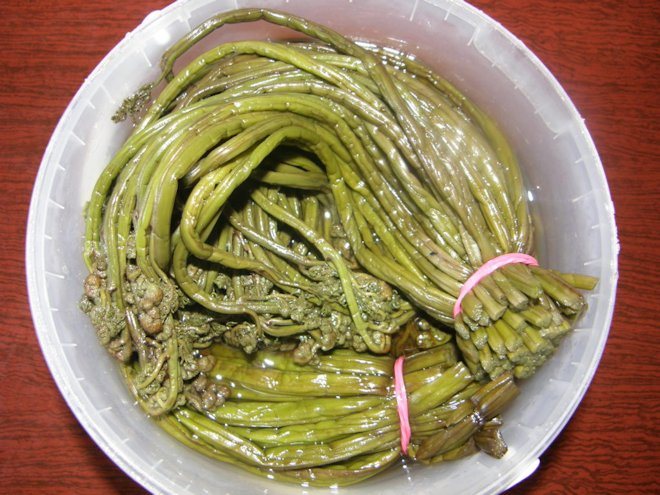

In Canada, bracken shoots can be added to flour after grinding. This gives the baked goods an extra flavor. In addition, the leaves of the plant are used to store food in winter to prevent rotting. It is also used in the production of beer drinks.
Use in traditional medicine
Eagle has found great use in folk remedies. It is used to treat a variety of health pathologies. Decoctions from dried shoots are used as medicines. Decoctions help to solve problems such as vomiting, diarrhea, helminthic invasions. In addition, the fern has found its use in the treatment of the following disorders:
- disorders of the nervous system - the broth helps to tone the human body;
- reduced immunity - the tincture contains a large amount of vitamins and useful properties that help to strengthen the body's defenses;
- pain - a decoction and tincture are used as a treatment for migraines, myalgias;
- diseases of the upper respiratory tract - the broth has antitussive and expectorant properties;
- arterial hypertension - bracken tincture is able to lower blood pressure;
- seizures;
- wound healing property - plant-based ointments help to cure abscesses and eczema.
Bracken has long been used as a remedy for arthritis and arthrosis, rickets and rheumatism. Ointments are made from ferns, which are rubbed into problem areas. Chinese medicine uses bracken as an antipyretic and medicine to treat infectious hepatitis.
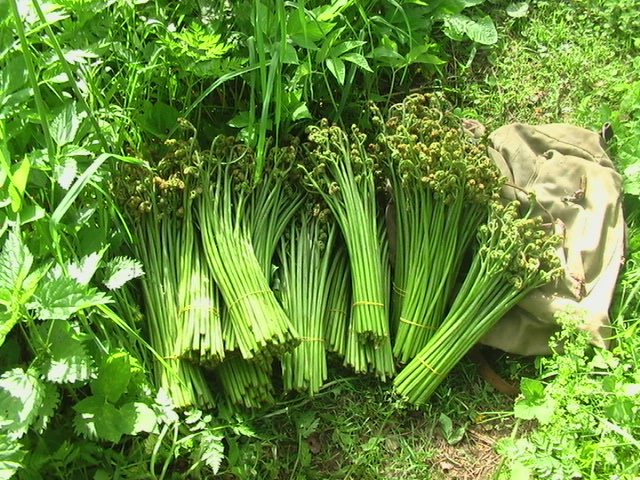

The plant's rhizomes help speed up metabolism and stimulate growth. In addition, a decoction from the roots has long been used as a means to relieve stress and increase the body's performance.
The use of bracken helps to remove toxins and radiation from the body. It is also used as a means to optimize hormonal balance in the body and maintain normal blood glucose levels.
The poison contained in the leaves can lead to disastrous consequences, therefore, it is impossible to treat problems with the help of a plant without consulting a doctor. It is forbidden to use decoctions and infusions for pregnant and lactating women, children, as well as people with an unexplained allergic history.

